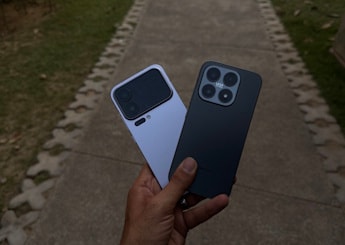- Home
- Science
- Science News
- Engineers Develop Stamp Sized Sticker That Can Provide Ultrasound Imaging for 48 Hours
Engineers Develop Stamp-Sized Sticker That Can Provide Ultrasound Imaging for 48 Hours
Researchers made volunteers perform activities, during which, the sticker maintained a strong adhesion and recorded the organs of the subjects.

Photo Credit: MIT/Felice Frankel
The team is now working toward enabling the device to function wirelessly
In what could revolutionise the way ultrasound imaging is performed, engineers have developed a stamp-sized sticker that sticks to the skin and provides continuous ultrasound imaging. Currently, this is done using sophisticated and heavy equipment that requires specialised technicians. These ultrasound machines provide live images of the heart, lungs, and other organs. However, they are mostly only available in hospitals and medical facilities, making them inaccessible for many.
This is what engineers at the Massachusetts Institute of Technology (MIT) have aimed to solve with their new creation. They obviated the need to use bulky machines and developed a small sticker that sticks to the skin and provides ultrasound imaging continuously for 48 hours.
Demonstrating the efficiency of the stickers, researchers applied them to volunteers and produced live, high-resolution images of blood vessels and organs such as lungs, stomach, and heart through the device. The volunteers were made to perform activities like standing, sitting, biking, and jogging, during which, the sticker maintained a strong adhesion and recorded the organs of the subjects.
In the current design of the device, described in the research paper, the sticker needs to be connected to an instrument that translates the recorded data or sound wave into images. However, if the device is made wireless, then, according to researchers, it could be used for a range of purposes.
“We envision a few patches adhered to different locations on the body, and the patches would communicate with your cellphone, where AI algorithms would analyse the images on demand. We believe we've opened a new era of wearable imaging: With a few patches on your body, you could see your internal organs,” said Xuanhe Zhao, professor of mechanical engineering and civil and environmental engineering at MIT. Zhao is also the senior author of the study.
The team is now working toward enabling the device to function wirelessly while they are also developing artificial intelligence-based software algorithms that will allow for better interpretation and diagnosis of the sticker's images.
Catch the latest from the Consumer Electronics Show on Gadgets 360, at our CES 2026 hub.
Related Stories
- Samsung Galaxy Unpacked 2025
- ChatGPT
- Redmi Note 14 Pro+
- iPhone 16
- Apple Vision Pro
- Oneplus 12
- OnePlus Nord CE 3 Lite 5G
- iPhone 13
- Xiaomi 14 Pro
- Oppo Find N3
- Tecno Spark Go (2023)
- Realme V30
- Best Phones Under 25000
- Samsung Galaxy S24 Series
- Cryptocurrency
- iQoo 12
- Samsung Galaxy S24 Ultra
- Giottus
- Samsung Galaxy Z Flip 5
- Apple 'Scary Fast'
- Housefull 5
- GoPro Hero 12 Black Review
- Invincible Season 2
- JioGlass
- HD Ready TV
- Laptop Under 50000
- Smartwatch Under 10000
- Latest Mobile Phones
- Compare Phones
- Honor Magic 8 RSR Porsche Design
- Honor Magic 8 Pro Air
- Infinix Note Edge
- Lava Blaze Duo 3
- Tecno Spark Go 3
- iQOO Z11 Turbo
- OPPO A6c
- Samsung Galaxy A07 5G
- Lenovo Yoga Slim 7x (2025)
- Lenovo Yoga Slim 7a
- Lenovo Idea Tab Plus
- Realme Pad 3
- Moto Watch
- Garmin Quatix 8 Pro
- Haier H5E Series
- Acerpure Nitro Z Series 100-inch QLED TV
- Asus ROG Ally
- Nintendo Switch Lite
- Haier 1.6 Ton 5 Star Inverter Split AC (HSU19G-MZAID5BN-INV)
- Haier 1.6 Ton 5 Star Inverter Split AC (HSU19G-MZAIM5BN-INV)







![[Sponsored] Haier C90 OLED TV | Dolby Vision IQ, 144Hz OLED and Google TV in Action](https://www.gadgets360.com/static/mobile/images/spacer.png)









